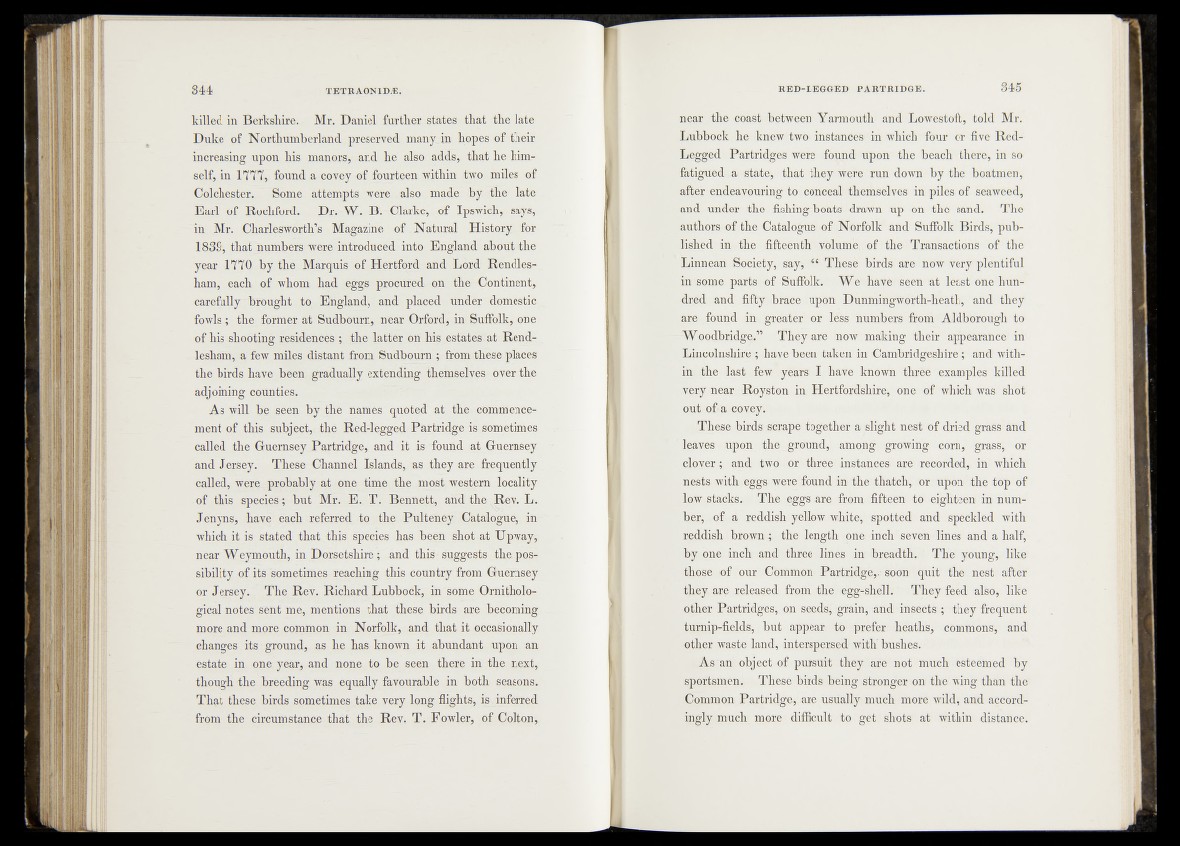
killed in Berkshire. Mr. Daniel farther states that the late
Duke of Northumberland preserved many, in hopes of their
increasing upon his manors,- and ;be also, adds, that he himself,
in 17717 found a covey of fourteen within two miles of
Colchester. Borne attempts were., also m a d e fy the late
Earl of Rochford. Dr. W. B.-Glarke^of Ipswich, says,
in: Mr. Charlesworth’s Magazine of ,N # ip a l History for
1839, that numbers were introduced into England about the
year 1770 by. the Marquis of Hertford: 'and Lord Rendles-.
ham, each of whom had #ggs procured on/ tH^-Continent.;
carefully'darought tQ England,' and placed under domestic^
fowls.; the former at Sudbourn, near Orford,- intSuffolk, of|gj|jj
of his shooting residences^'- the= latter oiLhis jest|s|e^at. Rend-
-lesham, a few miles distant from Sudbourn,;' from these^plhees
the birds have bheii gradually extending^ themselve^over -the
adjoining counties.
As will byjthe names' quoted' at-the etTmnfengpi;'
ment of this subject,,-the Red-legged Partridge,’is|§<|metimes
called the GuernseyJPartridge, and it is “found at Guernsey
and Jersey. These Channel Islands, as tkey-arc^requeut-ly#
called, were_ probably at one time the mpst|’w©steipif. locality
of this species'r; but 'Mr. E.. T . . Ben'neftj : and the .Rev. L.
Jfnyns, .have each refeSred; to . the. Pul teney f]pa,tarlogue, in
which it is stated .that this species - hasdbgyshot at Upwayy
near Weymouth, in !Q.orSetshire; .and this: ^ftgges‘ts;ythe,p-0Sr:
sibility of itskometimgipreaching this country from Guernsey
or Jersey.. The Rev. Richard Lubbock, in some Ornithological
-imtes, sent me, mentions that these birds are-becoming
more and more common in Norfolk,/;,,and that it occasionally
changes its - ground, „as he.;has known, it abundant upon an
estate in one; year, and none to be seen there in the" next,,-
though the breeding was equally favourable, in both, seasons.
That these, birds sometimes .fake very, long, flights, is inferred
from- the circumstance that the Rev. T. Fowler, of Colton,,
near the coast between Yarmouth and Lowestoft, told Mr.
Lubbock he knew two instances in which four or five Red-
Legged Partridges were found upon the beach there, in so
fatigued-a state, that they were run down by the boatmen,
after endeavouring to conceal themselves in piles of seaweed,
and under the fishing-boats drawn up on the sand. The
authors o ff he Catalogue^of' Norfolk; and Suffolk Birds, published
inv &et fifteenth volumeGof ; the Transactions of the
Linneanr^Sociqty, say! These "birds are ‘iioVr very plentiful
income partsKf-^Suffolk. We1 haye^seen* p t least one hundred
Sand fifty .^brace lup^n Dunmdngworth-heath, and they
’a r g ^ in ^ g f eM f lg r l or less numbers from A-ldborough to
^b^oodbridgel|p| They are now mating their appearance' in
Li®QolnsJb4^e^ have |te|h|taken^i# Cambridgeshire ; and within
jyh^dastrfew‘l |} ^ have known three'examples killed
m$M yar^rRo.yj,##^ in Hertfordshire;? one which was shot
Th@sg^hdftis|^ap^|©g^thor| a slight nest of dried grass and
leaves,*f/i|pon A|hov^r4und, umOnf|f$growmg ’c©rh, grass, or
S o y er,^ and instances', are recorded, in which
Tnjgste^with re^g/s^e|6|fp@nd in the thatch, or upon the top of
/lo|v';,st^fe,^||,@h|e,^^gs -are from1 fifteen to" eighteen?’in num-
lMj&*of- a reddish yPHow white;.’ spotted^ and speckled with
jm&ldhh brown ; tphe1 ^length one -ihefifiseven ■ lines' and a half,
i h’&^QnCi inchr-andk three.? Mn esM 1 n breadth. The' young, like
those , of our Common Partridge,;-soon quit the nest after
they; are^e'leased-f from the egg-shell; 4 They feed also', like
Other Partridghsftsln‘S'gCdI|igB|m| and-in-sects ; they frequent
turnip-fields, ^appear ^fpreferrdieath’s, ^commons, and
other wiSstie dand^^it^ES^I&^%withT bushes*.- '*
^%s'an? o|g.^pc@f pursuit itlfeyi are not much/esteemed by
sportsmen. These'ibi^|iKbeingAs^ii|i^§r;tt)n the wing than thei
It^opimon Partridge,' are usually much more wild, and accord-
inglytnuclp more difficult to get '1 shots at within distance.